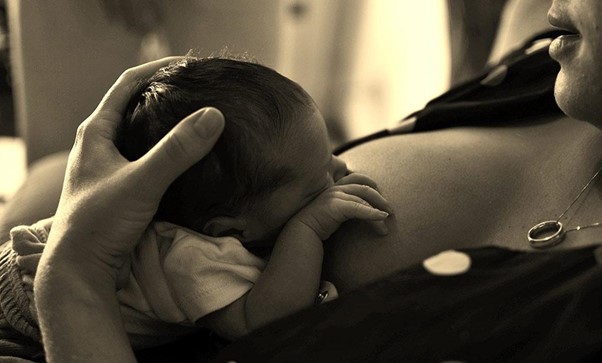
Breast/chestfeeding has so many benefits for mum and baby. But unfortunately, first-time parents with no experience are often unsure when it comes to breast/chestfeeding after birth. After all, they don’t know exactly what to expect. They hear and see a lot in advance. From glossy social media images of happy breast/chestfeeding to well-intentioned advice from family members and friends to honest and unembellished testimonials from mum friends… All of this influences their own expectations of what can and should happen after birth. This information can often cause uncertainty or even stress. As wonderful as breast/chestfeeding is, it can also be stressful at the beginning (but it doesn’t have to be).
Our midwife and breast/chestfeeding expert Katrin Ritter knows that although both parent and child are made for breast/chestfeeding, both have to learn it first. So that’s exactly what we’re sharing today: a “how to” for breast/chestfeeding a newborn. The more you know in advance about what happens when and how in your body and with your newborn baby after the birth, the more confident you will be in establishing breast/chestfeeding, and the more relaxed you can approach the topic. And relaxation is the be-all and end-all when breast/chestfeeding.
Successful breast/chestfeeding in the first week after birth starts during pregnancy
In a previous article, we talked about prenatal milk collection – expressing colostrum. Ideally, your preparation for breast/chestfeeding starts there if not before. The first hour after the birth is also crucial for a successful start to breast/chestfeeding. During this time, your newborn baby goes through nine phases of adaptation. Ideally, they should not be disturbed during these phases. That’s why it’s good to know what they are and why they’re important. Today’s blog article follows on from this first hour after the birth and explains step by step what breast/chestfeeding after the birth looks like in the best case scenario and how you can start breast/chestfeeding successfully.
Breast/chestfeeding a newborn – the “why”
The World Health Organisation (WHO) and UNICEF recommend “early initiation of breastfeeding within 1 hour of birth; exclusive breastfeeding for the first 6 months of life; and. introduction of nutritionally-adequate and safe complementary (solid) foods at 6 months together with continued breastfeeding up to 2 years of age or beyond”. In the UK we follow that recommendation. How long you feed your little one in total is of course up to you and your child.
And we cannot emphasise this often enough: All breast/chestfeeding is valuable! It has so many positive effects on your child and on yourself. Did you know, for example, that in the first 1000 days (from conception to the end of the second year of life) many decisions are made in your baby’s life that will influence your offspring in the long term? Including in the area of nutrition. This is why breast/chestfeeding is such an important, positive influencing factor. It has been proven that breast/chestfed children are less likely to suffer from diarrhoea, respiratory diseases and middle ear infections in the first few years of life. They have a lower risk of becoming overweight and are less likely to develop type 2 diabetes mellitus in the course of their lives. Breast/chestfed children are also less likely to die of sudden infant death syndrome.
Parents who breast/chestfeed their children have a faster uterine involution (a natural process that involves your pregnant uterus returning to its pre-pregnancy state), a lower risk of developing type 2 diabetes mellitus and there are indications that they have a slightly reduced risk of developing breast or ovarian cancer. In addition, there are many other positive influences of breast/chestfeeding on, for example, the cognitive and psychological development of children and the parent-child bond.
Breast/chestfeeding: the latest figures
Almost 68% of women in the UK start breastfeeding, only 48% continue beyond 6-8 weeks (source) which is below the recommendations. There are many reasons for this: milk supply, infections, health problems, lack of support from partners and family etc.
However, many of these reasons can be easily remedied with the support of a midwife or lactation consultant. Breast milk is “a miracle cure and we need to make sure that every child gets it!” says Dr Rebecca Hogan, neonatologist and head of breast/chestfeeding medicine at the Hospital for Sick Children. She compares breast milk to a pill “that could protect against inflammatory bowel disease (NEC), diabetes, allergies, cancer and much more.” And you’d pay all the money in the world for that, wouldn’t you?
Now that you know how important breast/chestfeeding is for you and your baby, here is a brief overview of the 4 different phases of breast/chestfeeding – from pregnancy to the end of the breast/chestfeeding period. Each phase is important – for successful breast/chestfeeding and the start or maintenance of sufficient milk production. The human body is fascinating and perfectly adapted to a baby’s needs.
The breast/chestfeeding process
The breast/chestfeeding process is divided into different phases:
- 1st phase: The prenatal phase begins in the last weeks before birth
- 2nd phase: The early postnatal phase: initiation of breast/chestfeeding, start of breast/chestfeeding in the first days/weeks after birth as a sensitive phase
- 3rd phase: Ideally, breast/chestfeeding becomes routine until the 6th month
- 4th phase: From the 7th month until the end of the breast/chestfeeding period: complementary foods are introduced and breast/chestfeeding is reduced more and more

How to: breast/chestfeeding a newborn
Wow, that was a lot of theory beforehand. But knowing this background is fundamental to understanding why breast/chestfeeding is so important. And this, in turn, can influence your attitude towards the topic and contribute to a better breast/chestfeeding start. But now we come to the crucial question of what a good start to breast/chestfeeding actually looks like. What should you look out for and how can you go about establishing breast/chestfeeding – as long as you and baby are well and baby was born at term?
- Early self-attachment of the child
Directly after birth in the nine phases of adaptation according to Widström. This means that your newborn has already been lying on your chest for a good hour or so. It has been allowed to relax, be active, crawl, familiarise itself with the new situation, suckle on its own and finally sleep a little. Only then will the baby be looked at, washed and changed. If this cannot happen for medical reasons then it makes sense to express colostrum and give it to baby.
- Uninterrupted skin-to-skin contact
There is no such thing as too much skin-to-skin! After the first feed after birth (within the first hour), the baby is examined and, dressed only in a nappy (and hat if necessary), placed directly on the birthing parent’s chest on bare skin. A bonding top can be useful to secure and baby and keep them warm. If you are in hospital, we recommend cuddling your baby inside this top or a blanket until you are discharged – and then also at home during the day. This way, your baby can breastfeed at any time and is kept warm. A wrap or newborn carrier is suitable for more activity.
- Frequent self-directed breast/chestfeeding or latching on
From now on, it’s all about latching baby on frequently to stimulate milk production and milk flow. If this is not possible for medical reasons, pump milk or express your colostrum.
Ideally, your baby should lie on your upper body while you lie slightly upright on your back. Approximately 4-5 hours after their first feed (please do not wait longer than 6 hours), you should feed your newborn again. In the following 24 hours, you should then feed a total of ten to twelve times, i.e. every one to two hours. More often if you want. It sounds like a lot, but it also increases the amount of milk. Not to mention the bonding and improved communication between you and your child.
If you feed your baby this frequently in the first 24 hours, the first bowel movement (meconium) will also be excreted more quickly, the risk of jaundice will be reduced and your baby’s blood sugar level will stabilise. Babies who experience nausea also feel better after receiving colostrum from their parent. In the first 24-48 hours after birth, you should only feed your newborn baby 5-15 ml per meal (don’t worry about trying to work out how much they’ve had if they feed directly from your chest). The little stomach cannot absorb any more. If you are unable to breast/chestfeed, try to feed your baby with a cup or spoon as this can prevent nipple confusion associate with bottle use.
- Effective suckling
For breast/chestfeeding to start successfully, it is important that your newborn sucks effectively and that the colostrum reaches your baby. And again: if breast/chestfeeding is not possible, stimulate the breast with a breast pump/your hands and feed the expressed colostrum to your baby. When baby suckles, the breast/chestfeeding hormone prolactin is released, which ensures good milk production. At the same time, skin-to-skin contact releases the hormone oxytocin, which also supports the breast/chestfeeding process. Both hormones are crucial for a successful start to breast/chestfeeding.
- No separation of parent and child
Unless there is a medical reason, you shouldn’t be separated from your child during this phase. This only causes unnecessary stress for both parties.
- Rest!
To ensure a successful start to breast/chestfeeding, please make sure that you have absolute peace and quiet during this first phase. This also means: (ideally) no mobile phones, no visitors, no media. Concentrate fully on yourselves. Cuddle for all you’re worth and feed again and again.
- Observe sensitively and react promptly
While you are lying there cuddling, pay particular attention to every little signal from your baby (search signals). If your newborn baby indicates that they are hungry, respond as quickly as possible. This way you will get to know each other better and better and your baby will learn that they can trust you 100%.
Important! Crying is your baby’s last signal. It means that they are frustrated because they have already signalled to you in many other ways that they want food. Once your baby cries, latching on is more difficult.
Look out for these signs of hunger:
- Sucking movements
- Sucking noises
- Licking the lips
- Rapid eye movements
- Restlessness
- Movement of the arms and legs
- Increase in body tension
- Turning the head back and forth
- Searching movements
- Learn how to use a breast pump and hand express
There are many reasons why it can make sense to pump or express milk. For example, it is helpful to extract a few drops to stimulate your baby to breastfeed. It helps if the milk ducts are blocked and can alleviate mastitis. You can also express and freeze milk from time to time later on so that you have a break and your partner can take over the feeding, if that’s something you both want.
How to: breast/chestfeeding a newborn – get support in establishing breastfeeding
Phew, that was quite a lot. And you’re not sure if you can manage it all? You will. Don’t worry. Why are we so sure? Because you’re already doing everything right by informing yourself. In addition, make sure you consult your midwife or a breast/chestfeeding counsellor and also inform your healthcare team that you would like to try breast/chestfeeding. This will give you more and more confidence. And they can help support you with the “how to” of breast/chestfeeding a newborn.
In the next breast/chestfeeding blog post we’ll be talking about all things to do with expressing milk. Too little milk, too much milk, building up a supply, involving a partner in feeding… there are many reasons why you might come into contact with a pump. So look forward to even more breast/chestfeeding knowledge.
Source: Die Nationale Strategie zur Stillförderung
Headline image from Pexels



